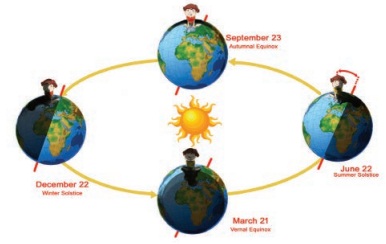The Universe and Solar System | Term 1 Unit 1 | Geography | 6th Social Science - Motions of the Earth | 6th Social Science : Geography : Term 1 Unit 1 : The Universe and Solar System
Chapter: 6th Social Science : Geography : Term 1 Unit 1 : The Universe and Solar System
Motions of the Earth
Motions of the Earth
Have you noticed the
Sun in the morning, afternoon or evening? Is it in the same place throughout the
day? No. It is seen in the east in the morning, overhead in the afternoon and in
the west in the evening. Have you ever thought of the reason behind it? This is
because of the constant moving of the Earth around the Sun. It seems that the Sun
is moving, but it is not so. This is similar to what you experience when you are
travelling in a bus or train. When you look out of the window, the trees, lamp posts
and other objects seem to be moving, but actually it is you who are moving. To understand
the motions of the Earth better, you need to be familiar with the shape and inclination
of the Earth.
Shape and Inclination of the Earth
The Earth is spherical
in shape. It rotates on its axis, which is an imaginary line that runs from the
North Pole to the South Pole passing through the centre of the Earth. The Earth’s
axis is always tilted or inclined from the vertical by an angle of 23½°. It makes
an angle of 66½° with the plane of the Earth’s orbit.
Fact:
The velocity
of the Earth’s rotation varies from 1670 km per hour at the equator to 845 km per
hour at 60° N and S latitudes and zero at the poles.
Rotation

It is the spinning movement
of the Earth on its axis. The Earth rotates from west to east (anti-clockwise) and
takes 23 hours 56 minutes and 4.09 seconds to complete one rotation. The time taken by the Earth
to complete one rotation is called a day. The rotation of the Earth causes day and
night. As the Earth is spherical in shape, only one half of it is illuminated
by the Sun at a time.
Fact:
The Midnight
Sun is a natural phenomenon that occurs in the summer months in places north
of the Arctic Circle or south of the Antarctic Circle, when the Sun remains overhead
24 hours a day.
The other half remains
dark. The illuminated portion of the Earth experiences day, whereas the darkened
part of the Earth experiences night. The line which divides the surface of the Earth
into a lighted half and a dark half is called the Terminator Line.
Revolution
It is the movement of
the Earth around the Sun on its elliptical path. The Earth takes 365 ¼ days for
it to complete one revolution. It revolves around the Sun at speed of 30 km per
second.

For the sake of convenience,
we take it as 365 days and call it a year. The remaining quarter day is added once
in every four years in the month of February. That is why February has 29 days once
in four years. It is called a Leap Year. The inclination of the Earth on
its axis and its revolution around the Sun cause different seasons.
Activity:
Circle
the leap years: 2000, 2005, 2012, 2014, 2017, and 2020
The Northern Hemisphere
is inclined towards the Sun for six months from 21st March to 23rd September while
the Southern Hemisphere is tilted away from the Sun.
From Sep 23rd to March
21st the southern hemisphere is inclined towards the Sun and the northern hemisphere
faces away from the Sun. The changing position of the Earth in its orbit during
revolution gives the impression that the Sun is continuously moving north and
south of the equator.
HOTS:
Priya is 12 years old. How many
times she would have revolved around the Sun?
The equator faces the
Sun directly on 21 March and 23 September. These two days are called Equinoxes,
during which the day and night are equal throughout the Earth.
Perihelion is the Earth’s closest position to
the Sun. Aphelion is the farthest position
of the Earth from the Sun.
On 21st June, the Tropic
of Cancer faces the Sun. This is known as Summer Solstice. It is the
longest day in the Northern Hemisphere and longest night (shortest day) in
the Southern Hemisphere. On 22nd December, the Tropic of Capricorn faces the Sun.
It is called as Winter Solstice. It is the longest day in the Southern
Hemisphere and longest night (shortest day) in the Northern Hemisphere.
HOTS:
If the Earth is not inclined at 23 1/2º angle, what would happen to the
Earth?
Related Topics